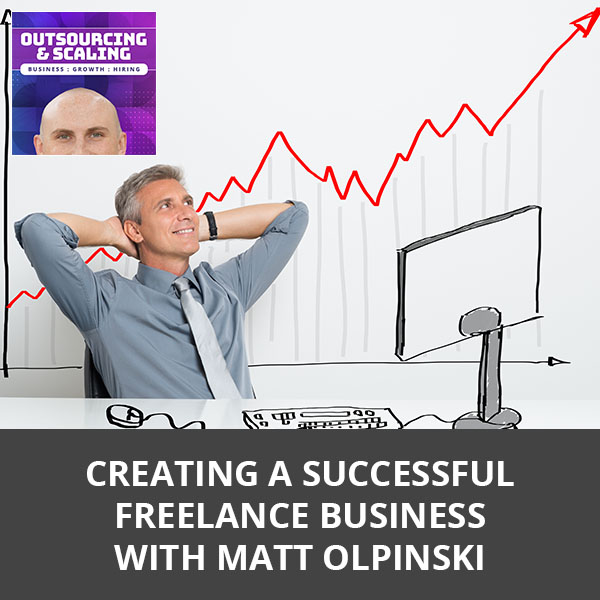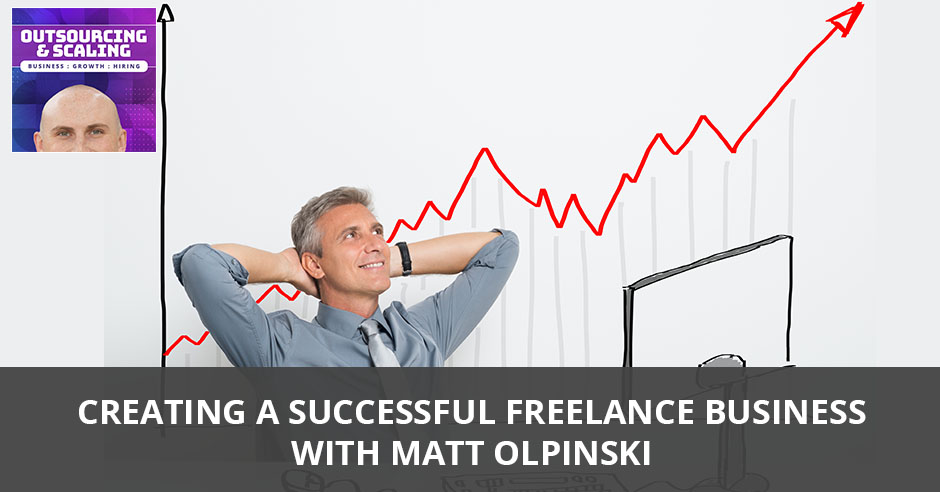


Freelancing is a dream come true for people who don’t want the usual 9 to 5 work routine. What does it take to become successful in this field? Matt Olpinski is the owner of The Freelancer Institute, an exclusive Slack community that he created to help freelancers learn. Brushing on topics that include taxes, handling finance, and the discipline that’s required in the business, he tackles how he succeeded in freelancing and gives insights on how aspiring freelancers can increase their rate and provide more value to their clients.
—
Listen to the podcast here:
[smart_track_player url=”https://www.podetize.com/statsapi/www.podetize.com/wp-content/uploads/fileuploads/11-5b145ef137b51b3d1af0633e9305c43d/04/2019/fd883de6e57ca5144b9cec62a4fed22c.mp3″ title=”Creating A Successful Freelance Business with Matt Olpinski” artist=”Nathan Hirsch” image=”https://freeup.net/wp-content/uploads/2019/04/OAS.png” ]
Download the audio file here.
Creating A Successful Freelance Business with Matt Olpinski
We have a special guest, Matt Olpinski. Matt, how are you?
I’m doing great, Nate. How are you?
I’m doing great. Matt owns The Freelance Institute. Why don’t you tell people a little bit more about that and then I want to jump into your backstory?
The Freelance Institute is an exclusive Slack community that I created specifically to help freelancers learn. The short version of the story is I started a newsletter when I first began full-time freelancing. Over the years, I have responded to hundreds of emails from subscribers that have these unique and specific questions about how to do things. I’m spending all this time writing these emails back to them and trying to help them. I have always had a passion for helping people. After passing 1,000 subscribers, I started to realize this isn’t scalable. I’m not going to be able to personally give advice to everyone that’s emailing me. I was thinking of ways where I could reach more people and connect more people and help people learn not just from me but from others too.
I wish that there was a way that more people than just the individual I was writing to could benefit. Blogs and YouTube channels are good, but the advice tends to be more generalized. Sometimes you end up having more questions at the end of it than you got answers. The Freelance Institute, being a Slack community, the real-time communication, the sense of community, the ability to pull out your phone whenever you want and ask someone a question about a situation that you might be in. I thought it was a unique way to solve this problem and bring more people together. I leveraged my network to get some seasoned freelancing experts in the channels and dedicated the channels specifically to topics that I think freelancers are going to have a lot of questions about. It’s less of a casual hangout, more of a valuable learning tool and connecting people for things like referrals, collaboration, job opportunities. Things like that also happen in there. It’s been a neat experience to start this and to see where it’s taking off.
Those of you that know me and know FreeUp know that we love freelancers. We love building the freelancer community. If you have read the episodes before, we have a lot of different clients on marketing agencies, marketing experts and eCommerce gurus. I wanted to bring someone like you on who is not only a freelancer but knows the freelance or industry and how that’s changing, how that’s evolving and how you can have success there no matter what your skill set is. Before we dive into that, let’s take a step back. Before you were freelancing, tell us a little bit about your backstory and how it led to what you’re doing now.
Freelancing is a massive responsibility. The discipline that’s required to do something like working from home is just not for everyone.
From a young age, I was always into making things look good, whether it was creating something with Legos or K’NEX. When I got to high school, it was art. Then I got into coding a little bit and it was a different expression of creativity and things like that. Going to college, I ended up in a digital design program. Essentially, we learned everything from UI and web design to animation and 3D modeling and all this stuff. It was really fun. When I was a freshman in college, I took a web design and development course. It was the first time that I’d ever done anything related to websites. I was blown away and I was fascinated that you could type some text into the computer and get this instant result. It was this instant satisfaction. I was like, “This is the same thing that I grew up loving, just now I can do it on the computer and I can make money from it too.”
As soon as I got done with that class, I started picking up freelance jobs. Someone would say, “I heard you know how to make websites an hour or something.” Somebody would get in touch with me. My mom would recommend someone to me or someone I had known in another class at school would recommend someone. These little projects started happening. I almost stumbled into freelancing accidentally through these organic referrals. I did that all through college and it didn’t make that much money. In total of the four years I was in college, I made $10,000. That boils down to $2 an hour at fifteen hours a week. Not really good, but I had a lot of experience and I messed up a lot. There was no risk because I was in school. I wasn’t worried about paying my mortgage or anything like that. It’s a very low-risk. I got to learn a lot and then I got a normal job.
I was an interactive art director at a small company in upstate New York, which was great. I loved the company. I’m making good money. I’m working with people I liked, so there was no reason to leave and I never considered leaving. Freelancing was something I did on nights and weekends for extra cash, but I loved doing it. It was more than money. I love being in charge of things and the whole taking control of the whole freelancing process. Working with the clients, communicating, delivering something cool or seeing something I made come to life and getting paid for that. That was fun. Three years after that, so seven years total, I ended up leaving that job because I was doing better at freelancing than I was in my full-time job. It was a natural transition at that point. It’s been a few years since then that I have been full-time.
I love the story. It’s very similar to me. I started my business in college because there was no risk. You fail you and for me, I had different options. For you, you took the job and then migrated your way back into the freelancing and running your own business. A lot of people, at least from the clients I talk to, they want to get in the head of a freelancer. Why become a freelancer? I told them first of all, everyone has different reasons. Just because you tell us your reason doesn’t mean that someone else has theirs. There are pros and cons like everything in life. I’d love to hear from you what do you think the biggest pros are and what the cons are even now?
From my perspective, it’s different for everyone. It is such a cliché thing to say but I love the freedom. More specifically, what I loved about it was I liked being able to control one, what I was earning financially and two, the people that I was working with. When you’re at an agency, the agency decides which clients to take on, which ones who don’t. Even at a small agency, there’s relatively little influence. You don’t have a lot of control over the rates that you’re charging and how you’re doing estimates. There were a lot of business-related things that I was looking at and I feel like I could do it a little bit better. I didn’t have an opportunity to do that. That was something that I gravitated towards personally. A lot of people mess that up. They get into freelancing for the freedom and they don’t have a passion for the business side of things and then it doesn’t work because of that. I feel like that’s very important.
I originally gravitated towards the business side of things. I wanted to improve that and I couldn’t do it where I was. I thought that I would make the transition and tackle that stuff on my own. It ended up working out well. That’s also one of the cons of freelancing at the same time. That’s what you have to deal with. You have to get good at the business side of things. You become a salesperson. You have to get good at selling yourself, selling your services and it’s a massive responsibility. You take on a huge amount of responsibility and the discipline that’s required to do something like working from home is not for everyone. As much as it’s exciting to work from home and have your own clients and all the great things that come along with freelancing that you hear about, it’s a lot of work. It’s a lot of discipline and dedication and you got to be prepared for the unpredictable nature of freelancing sometimes. The goal is to make it more predictable. The reality is that you deal with unexpected things all the time and you have to be good at navigating that.

I’m glad you brought that up. I’m thinking of it from the business side of it and the freelancers that fail a lot of times we’re the ones that they’re so used to working for someone else, depending on someone else and using their systems. We have a lot of freelancers in the FreeUp community. We love to see them scale and we try to support them however we can. If someone comes to me and they’re like, “I’m trying to grow this thing. I’m hitting some bumps in the road,” the first thing I ask them is, “Are you looking at yourself as a business? Are you focusing on growing the business of being a freelancer?” A lot of times they’re not.
With the business, there’s the marketing, lead generation, SEO and accounting. There are all those other things around being a graphic designer. If you want to be a graphic designer, go get a graphic designer job. If you want to be a freelancer and a business owner, you got to bring all those things together and just wanting to experience anything else. You scaled this freelance business. You’re now what I would consider a high-level freelance or a high-level consultant. Give us some tips. How did you go from zero to $10,000 a month? How did you go to more? Where are you at now and how do people scale to that level?
This is the thing I always have to say because it’s a deeply integrated part of my own story, but nobody wants to hear, is that it takes time. I did it in college. There was no risk and it was years. It was four full years of doing it on nights and weekends. Then I got a job and did it for another three years on nights and weekends. I’m not saying that everyone needs to spend seven years doing it, but I’m saying a good place to start might be if you’re in college, get a normal job or get a day job and see if it’s right for you. Do It on nights and weekends. If you can’t freelance on nights and weekends with some level of success and sustain a full-time job, you probably aren’t cut out to be a business owner in my opinion. It takes as much effort when you transition.
A lot of people think, “I’ll have more time when I’m a freelancer,” but the reality is that it takes just as much, if not more effort and more time than what you’re putting in doing those two things at once. A good place to start and to minimize your risk is to freelance on nights and weekends and experiment. That’s when you can raise your rates and not be afraid of losing the job. That’s when you can learn how to communicate with clients. That’s when you can learn how to sell yourself and work on your website. Start attracting clients to your own online business, your own web presence versus constantly trying to chase after clients on different platforms and things like that. A good way to start too is to use freelancing platforms to get your initial set of clients. I think that’s awesome. FreeUp is a great resource for that. That’s pretty much what I did.
The short version is I did it for a long time, part-time. I slowly raised my rates, then I learned about fixed pricing and value-based pricing. I started off doing marketing websites and then marketing website builders came along. It was like, “Why do clients need to pay me $10,000 to do this? They can do it on Wix or Squarespace for a couple of dollars a month. They don’t need me anymore.” When I started to see that pattern happen, I started to transition to more of the high-value things like online tools, internal business applications, web apps or mobile apps or things that you can’t theme out of the box. The more proprietary stuff that is more valuable to the businesses. When I started seeing myself as a business, I started treating myself as a high-value consultant, raising my rates and my pricing was reflecting that and communicating value to the client.
“I’m going to do this project for you at this price because it’s going to add this much value to your business and we’re working on a system for you that is that valuable.” That’s when I started to see a big shift and make a lot more money. I get away from the commodity-style work that clients usually want like, “Build me this thing for this price and I’m going to get the lowest cost possible.” That was a big way that I started to transition away from that and get these high-value projects where now I’m only working on three to five projects a year instead of 30 or 40.
Make sure you have a system for scheduling and an assistant for your finances.
Talk a little bit about fixed pricing. I heard this saying like you hire a freelancer for 30 minutes and the freelancer looks at it like, “You’re not paying me for that 30 minutes. You’re paying me for the five years before that I spent gaining the skills to execute it in that 30 minutes.” Fixed pricing has a lot of value on both the client and the freelancer side. Can you talk a little bit more about that?
Fixed pricing is very dangerous because a lot of people mess it up and do it wrong. I wouldn’t say there’s a right or a wrong pricing method. My latest blog article is exactly about that where I think that there are certain projects where time-based billing makes a lot more sense and where the scope is more loosely defined. When you agree to a fixed price, you have to know and have a good and well-defined scope of work. Otherwise, you’re going to come out not ahead. You’re going to come out way behind on that one because you’re going to spend more time working on it with a fixed price. If you charge $1,000 for something and you plan on it taking five hours and ends up taking fifteen hours, then your effective hourly rate shrinks and shrinks the longer you work on it.
With fixed pricing, the scope of work’s got to be clearly defined. Whenever you do fixed price and I have to throw in value-based pricing here too, a lot of people don’t know what value-based pricing is. It’s simply a fixed price project where you’re anchoring the price against the financial value that you’re providing to the business. You can do fixed pricing and I always recommend when you do that, the conversation shifts from billing for time versus billing for results or an outcome.
You’re telling the client that you’re paying for an outcome like you said. That’s the key difference and it changes the whole power dynamic between you and the client for the entire length of the project. It positions you as an expert and you’re getting paid to produce a specific result. It doesn’t matter how long it takes you. That’s why it doesn’t matter if it took someone 40 hours to redesign the Nike logo or something. It’s almost the level of risk too. If they do it wrong, think about the impact on their business. They’re going to lose millions, maybe billions of dollars on that so to get it right, they have to spend the money to do all the research and everything that would go into that.
If there’s a client out there and they want to go behind the scenes and see what it’s like in the life of a freelancer, there are freelancers out there that are getting and going. What are some things that people don’t think of it that we haven’t already talked about? In freelancing in general, what are some things that people don’t think about when you’re looking at it from the freelancer side?
The biggest one that comes to mind is the ability to manage your finances correctly and manage your taxes. That’s such a foreign thing. If you have an employer, they’re handling all that for you. They’re taking out the taxes. They’re taking out all that stuff in your paycheck and you’re just getting a paycheck. You have to do all that on your own and it gets more complicated. You’re paying quarterly taxes. If you’re not taking that percentage and putting it away right away, you’re going to end up having to pay in a lot at the end of the year. That’s where a lot of people stumble. The ability to get a $10,000 paycheck is so exciting, but then the ability to take it and cut 40% of that away and keep it aside is a difficult thing to do and then to pay in taxes on that. The financial side of it and the scheduling aspect too.

A lot of freelancers have a hard time scheduling projects. They get overwhelmed. They either get too much on their plate or there’s no consistency. One thing I like to do is I always keep two projects on my plate at any given time. I don’t ever do more than that. One of them tends to be a long-term retainer agreement. Some reliable income, whether it’s a three-month contract or a six-month contract. I have even done twelve-month contracts with clients I have had a good relationship with. I know that’s where my income is coming from. It minimizes the risk. At the very least, that retainer slot should be able to cover my bills. The other slots, and maybe that’s twenty hours a week, the other fifteen or twenty hours a week is reserved for smaller faster turnaround projects.
Maybe it’s a couple of weeks. Maybe it’s four weeks, six weeks, eight weeks, something like that. There are more of a revolving door so I can take on more of those things. I have this baseline established consistency and that’s where my predictable income comes from. Then I leave room for those smaller projects and it never goes beyond that. I know when I’m fully booked if those two slots are already filled. It helps me manage expectations for my clients and also for me internally. I know when I’m booked out. Those things are important and I feel like people just take whatever comes their way because they don’t want to lose out on the money. It’s important to make sure you have a system for scheduling and a system for your finances too.
This has been great insight inside not just a mindset, but the day-to-day life of a freelancer. If people want to learn more about you and learn more about The Freelance Institute, how can they do it?
To learn more about me and what I do and what I offer, my website is MattOlpinski.com. There are lots of good resources there for clients and for freelancers. I have a blog and a newsletter for freelancers and some products available and some helpful resources. The Freelance Institute got its own brand and its own website. That is TheFreelanceInstitute.com. You can go there and learn all about the benefits of the Slack community, what you can expect from joining and why we’d love to have you be involved.
Thanks so much for joining us and we’ll talk soon.
No problem. Thanks, Nathan.
Important Links:
About Matt Olpinski
 Matt Olpinski teaches thousands of freelancers how to get more clients, raise their rates, and create a better life for themselves.
Matt Olpinski teaches thousands of freelancers how to get more clients, raise their rates, and create a better life for themselves.
Ever since he left his salary job behind, he’s consistently earned a six-figure freelance income each year and has worked with clients such as Facebook, Marriott, Bloomberg, and American Express.
He wants to show you how to take your freelancing career to the next level using his proven methods for success so you can build a healthy, sustainable, and satisfying freelance business.
